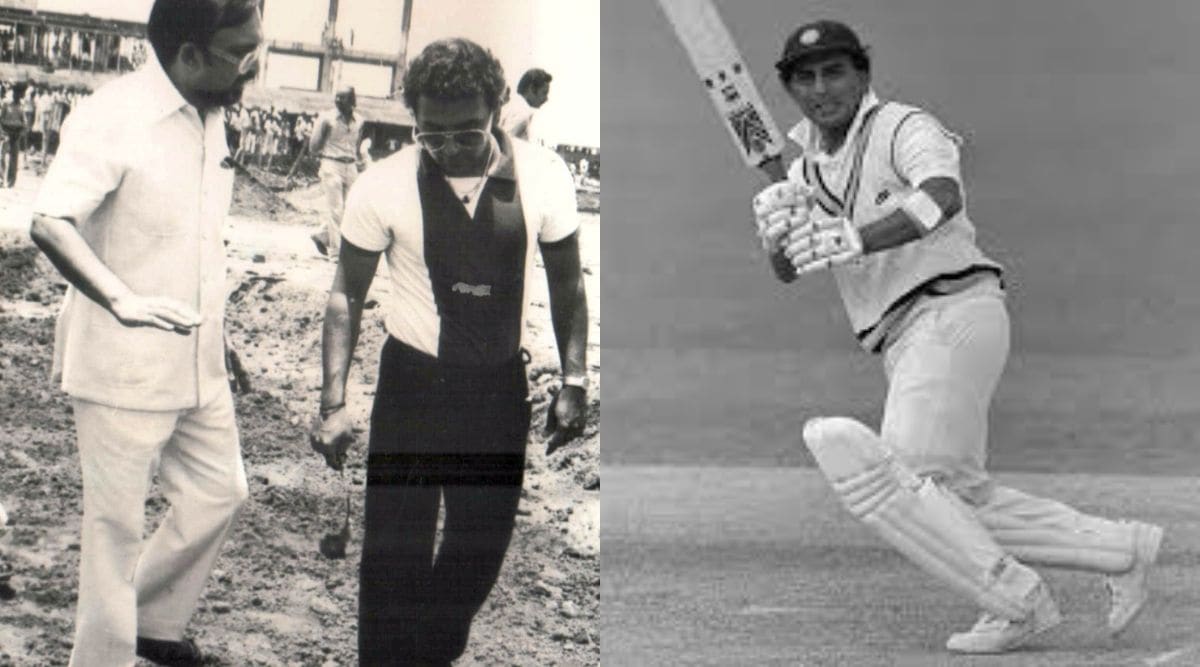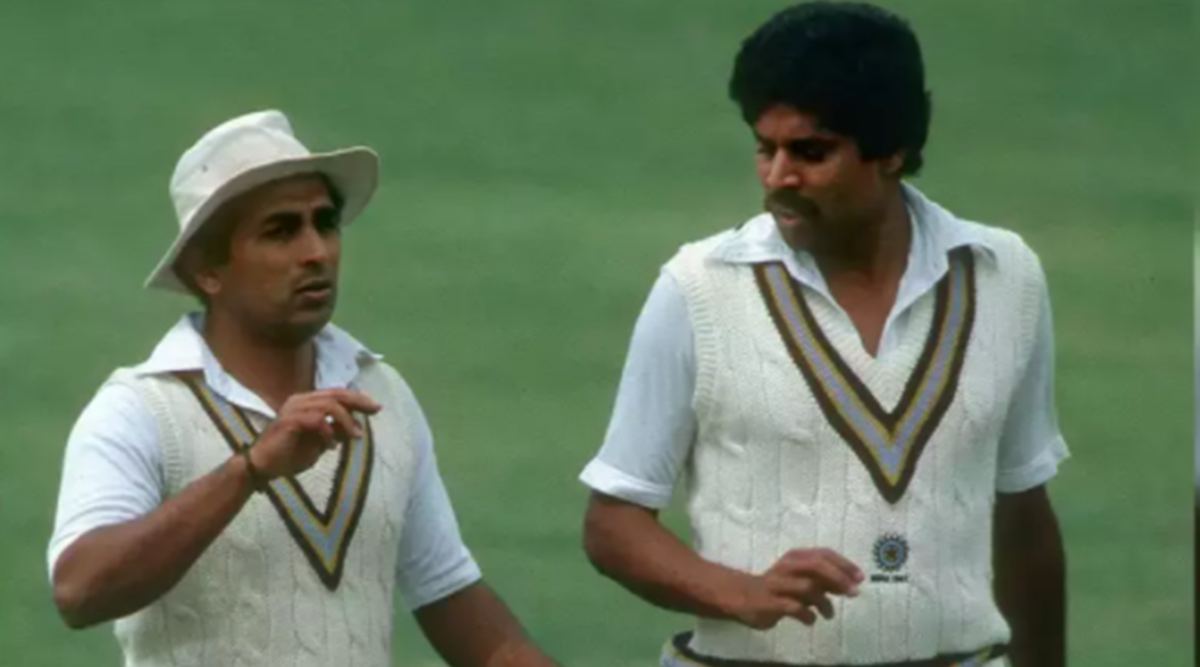 Four years before his historic crossing, Sunil Gavaskar visits the Motera stadium under construction.
Four years before his historic crossing, Sunil Gavaskar visits the Motera stadium under construction.“I knew that I needed 57 runs. I normally don’t look at the scoreboard. But once you reach a 50, you get an applause. At that stage you realise. If I’m not mistaken I got to my 50 with a single. So I was aware that now 7 more runs,” Sunil Gavaskar once told The Indian Express about the crossing.
“Once you get to that 10,000 it is absolutely magical. Magical because it had not been done before. Even 9,000 had not been done before, and I did it. But 9,000 is a four-digit number. 10,000 is a five-digit number, so it was almost like climbing Mt Everest for the first time,” says Gavaskar. With a soft chuckle he added how the world only remembers the first-timers — Edmund Hillary and Tenzing Norga.
 Kapil Dev and Sunil Gavaskar were the star performers for India as the West Indies were conquered in Berbice in 1983. (File Photo/BCCI)
Kapil Dev and Sunil Gavaskar were the star performers for India as the West Indies were conquered in Berbice in 1983. (File Photo/BCCI) The mountaineering metaphor works but it isn’t truly apt. Unlike Hillary or Tenzing, Gavaskar didn’t have the time to enjoy the happy, heady vertigo while looking down from the roof of the world. The chilling solitude of the world’s highest point is in total contrast to the chaos of the sweaty, dusty, noisy Motera. Those days, the 80s, for the locals in Ahmedabad, a day at the game was as much about watching cricket as it was about hurling abuses and stones. Eye-witnesses of the historic Test talk about Pakistan players fielding on the fence wearing helmets. Pandemonium broke out in the stands after “the run”. As was the tradition during those good old days, fans climbed over the fences, jumped across the moat to give the Little Master company on Mt 10,000. For once, the act of the overzealous trespassers seemed justified. Most of India wanted to jump over the fence and reach out to Sunny.
Even today if you want to make a 40-plus Indian cricket follower first beam and then bore you to death with Gavaskar stories, just mention Ijaz Faqih. In the days following that Gavaskar Test, Faqih, the Pakistan all-rounder with a French beard, would become more famous in India than in Karachi. He played a big hand in India uncrossing its fingers, it was off his ball that Gavaskar scored his 10,000th run.
Best of Express Premium
For a nation on the edge, suffering a collective bout of those nervous 9900s, every Gavaskar stride on the cricket pitch was an event. Note for the younger fans: it was like Tendulkar’s ‘100 hundred’ wait, maybe slightly less agonising and the eventual relief much more celebratory.
That 10,000th run had come in March 1987 on the back of anxious wait for the fans as runs weren’t flowing in the customary ‘SMG’ way. That evening he spoke to Doordarshan. “I was very keen to get it done fast. It was getting to me, everybody meeting me going 10,000, 10,000 – so I am really happy that’s past now.” Relief first before the full import of the achievement came.
In years to come, Doordarshan would dutifully lose the tapes of Indian cricket’s big moustache twirling moment from the very eventful and joyous 80s. Luckily, ‘the run’ had been speared so deep into the mind that it has stayed fresh. At 38, Gavaskar was stockier, looking every bit the father of an 11-year-old. The iconic ‘10,000’ picture — thankfully a few B/W photos have survived — shows him in mid-stride, sprinting down the pitch with his bat raised. He is bent double, almost at a right angle, his Panama hat-protected head buried in his chest. The pose has gravitas; worthy of being replicated into a stone sculpture and to be ceremonially mounted on a perch outside Wankhede. Even if carved in stone, the man who was known to never check the scoreboard while batting would look to be in a hurry, for he knew this was ‘the run’.
Luckily, there also exists a grainy YouTube video with a news clip about the crossing and the faces of those who have watched him bat would crease into a smile at the sight of how quickly Gavaskar recovers from his relief-tinged-joy to look for more runs; he brings down the raised bat around mid-pitch during the first run, and dashes not just for the second but also casts a glance at Dilip Vengsarkar exploring the possibility of the third. Only after resigning to the fact that an extra run can’t be squeezed, does he turn, pump his bat up, and raise his left hand to acknowledge the applause.
The Indian Express issue, dated March 8, 1987, has a story ‘Sunny day in Ahmedabad’ on the front page. It speaks about President Zail Singh conveying his congratulation through the Gujarat governor. It also records Maharashtra CM SB Chavan’s pat on Gavaskar’s back and a charming best wishes telex message from the great MGR on behalf of the people of Tamil Nadu.
However, it’s an advertisement that best captures the pre-liberalisation era and the importance of the ‘10,000 moment’ for a nation with global aspirations. From the bottom right corner on the sports page, the makers of “Diamond TV Antenna Booster” paid “rich tribute to the finest cricketer the world has ever seen”. India could no longer tolerate weak TV signals and the frequent terrace trips to adjust the antenna on match days. The 1983 World Cup win, World Championship triumph in 1985, now 10,000; India wanted a better look at their superstar and an undisturbed view when history was being written. The booster business certainly had potential.
 Sunil Gavaskar (Archive)
Sunil Gavaskar (Archive) It was also the decade when less was more. 10,000 was a grand figure that attracted awe and attention. 10,000 on salary cheque made you the most eligible bachelor. It was also in 1987 that Sanjay Dutt starred in a modestly successful film called Inaam Dus Haazara, a remake of the Hitchcock classic North by Northwest. Be it on a film poster, a matrimonial ad, ransom note or some ‘Wanted’ notice on the wall; 10,000 had an unexplained ‘come hither’ mystic about it.
Gavaskar has a few 10,000 memories that never made it to television or the newspapers. “It was a slightly dazed feeling. But the thing I remember most is that we were in Ahmedabad. And it’s a dry place. But Kapil somehow managed to get some champagne! That was amazing. He was the captain, and he organized, with special permission of course, to get some champagne,” he told this newspaper.
“I am not too sure whether today’s support staff and sports nutritionists would allow us to have even a sip of champagne in the middle of a Test match.
- The Indian Express website has been rated GREEN for its credibility and trustworthiness by Newsguard, a global service that rates news sources for their journalistic standards.

